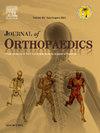血流限制联合神经肌肉电刺激对膝关节功能的影响:一项系统回顾和荟萃分析
IF 1.5
Q3 ORTHOPEDICS
引用次数: 0
摘要
目的探讨限血联合神经肌肉电刺激对股四头肌力量、肥厚、疼痛和疲劳的影响。设计采用荟萃分析的系统评价。文献检索pubmed, Scopus和Web of Science从成立到2023年11月。研究选择标准:随机和非随机的人类临床试验,研究限制血流和神经肌肉电刺激膝关节的联合作用。数据综合使用随机效应模型将相关数据汇总到各个研究中。计算每个原始研究的Cohen's D和一个总体估计值,以及一个双侧p值<;0.05认为有统计学意义。结果294项记录中,有9项研究,257名参与者被纳入系统评价。一项荟萃分析显示,在2周、3周和6周时,股四头肌力量没有显著差异。同样,在7-15分钟、2周和6周时也出现肥大。结论限制血流联合神经肌肉电刺激对股四头肌力量和肥厚的影响与原有的孤立技术无关。此外,使用后会引起更高的疼痛和疲劳水平。本文章由计算机程序翻译,如有差异,请以英文原文为准。
The effect of blood flow restriction combined with neuromuscular electrical stimulation on knee joint function: A systematic review and meta-analysis
Objective
To determine whether the combined application of blood flow restriction and neuromuscular electrical stimulation significantly affects quadriceps strength, hypertrophy, pain, and fatigue.
Design
Systematic review with meta-analysis.
Literature search
PubMed, Scopus, and Web of Science from inception to November 2023.
Study selection criteria
Randomized and non-randomized full-text human clinical trials published in English investigating the combination between blood flow restriction and neuromuscular electrical stimulation on knee joint.
Data synthesis
The correlation data was pooled across studies using a random effects model. Cohen's D was calculated for each original study and an overall estimator, and a two-sided p value < 0.05 was considered statistically significant.
Results
Out of 294 records, nine studies with 257 participants were included in the systematic review. A meta-analysis revealed no significant differences in quadriceps strength at two, 3, and 6 weeks. Similarly, it was also shown in hypertrophy at 7–15 min, 2, and 6 weeks.
Conclusion
The blood flow restriction combined with neuromuscular electrical stimulation had no additional effect to the original isolated techniques on quadriceps strength and hypertrophy. Moreover, causes higher pain and fatigue levels after its use.
求助全文
通过发布文献求助,成功后即可免费获取论文全文。
去求助
来源期刊

Journal of orthopaedics
ORTHOPEDICS-
CiteScore
3.50
自引率
6.70%
发文量
202
审稿时长
56 days
期刊介绍:
Journal of Orthopaedics aims to be a leading journal in orthopaedics and contribute towards the improvement of quality of orthopedic health care. The journal publishes original research work and review articles related to different aspects of orthopaedics including Arthroplasty, Arthroscopy, Sports Medicine, Trauma, Spine and Spinal deformities, Pediatric orthopaedics, limb reconstruction procedures, hand surgery, and orthopaedic oncology. It also publishes articles on continuing education, health-related information, case reports and letters to the editor. It is requested to note that the journal has an international readership and all submissions should be aimed at specifying something about the setting in which the work was conducted. Authors must also provide any specific reasons for the research and also provide an elaborate description of the results.
 求助内容:
求助内容: 应助结果提醒方式:
应助结果提醒方式:


